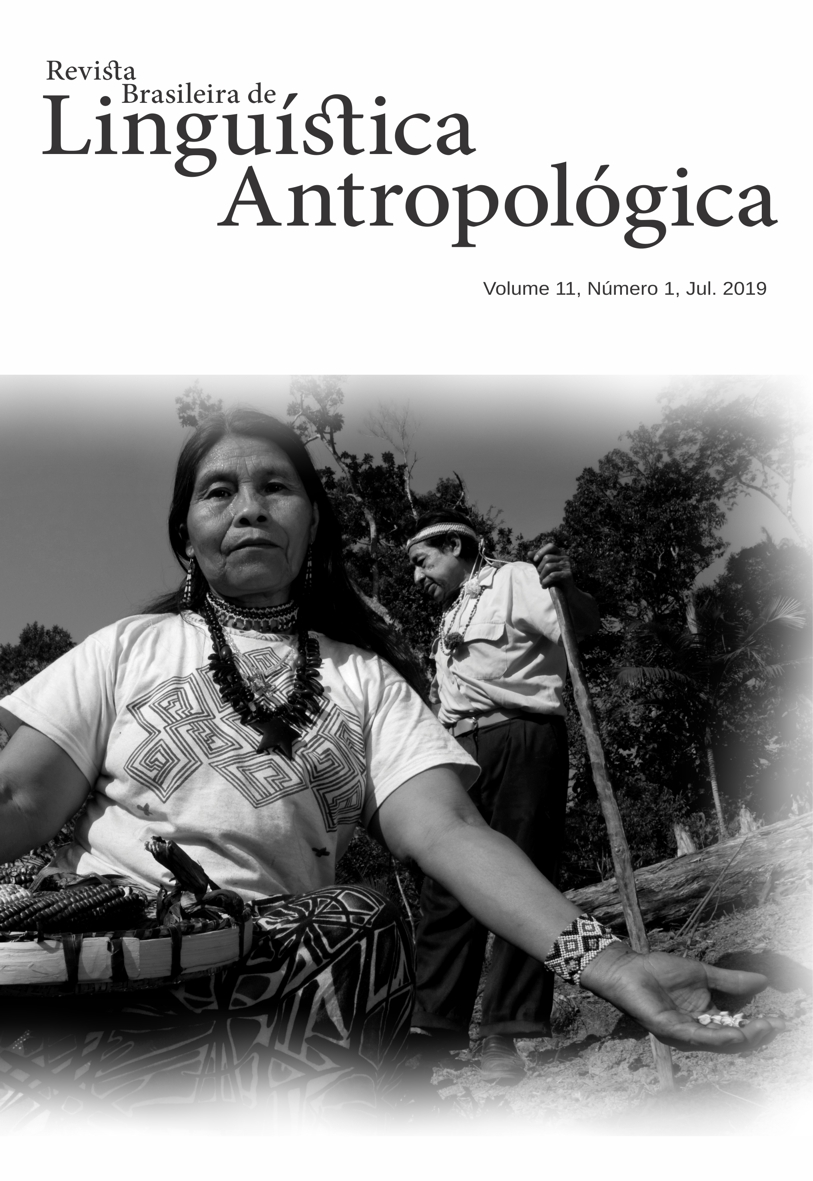Metáfora das emoções Kaiowá
DOI:
https://doi.org/10.26512/rbla.v11i1.26440Keywords:
Kaiowá. Metaphors. Emotions. Py’a. Teko.Abstract
This paper presents a description of some metaphorical linguistic expressions that encode emotions and feelings in Kaiowá, a language belonging to sub-branch I of the Tupí-Guaraní linguistic family of the Tupí stock. The work is based on the Theory of Conceptual Metaphor (TCM) which understands that metaphor is a mechanism of human cognition that plays a fundamental role in the construction, organization and understanding of the world and human experience. (Lakoff e Johnson 1980). The corpus was constructed from data gathered during interviews with Kaiowá speakers, following the methodological principle Usage-Based Models of Languages (Barlow e Kemmer 2000). In Kaiowá, the liver - py'a ”“ is the place of the emotions and the means of teko is the basis for the description of emotional and sentimental phenomena inherent to human beings.
References
Abreu, D. T. B. 2015. Metáfora e emoção: sobre a conceptualização na língua portuguesa. Tese (doutorado) Universidade do Vale dos Sinos. Programa de Pós-Graduação em Linguística Aplicada.
Carvalho, R. B. 2018. Análise morfológica da língua Kaiowá: fundamentos para uma gramática e dicionário bilíngue. 2018. 115 f., il. Dissertação (Mestrado em Linguística) ”“ Universidade de Brasília, Brasília.
Gibbs, R. W. 2006. Embodiment and Cognitive Science. Cambridge: Cambridge University Press.
Johnson, M. 1987. The body in the mind: the bodily basis of the meaning, imagination, and reason. Chicago; London: The University of Chicago Press.
Kövecses, Z. 2002. Emotion concepts: social constructionist and cognitive linguistics. In: Fussel. S. (ed). The Verbal communication of emotions. New York: Psychology Press.
Kövecses, Z. 2005. Metaphor in culture. Universality and variation. Cambridge: Cambridge University Press.
Revista Brasileira de Linguística Antropológica64Metáfora das emoções em Kaiowá.
Kövecses, Z. 2010. Metaphor: a practical introduction. 2 ed. Nova York: Oxford University Press.
Lakoff, G. 1987. Women, fire and dangerous things: what categories reveal about the mind. London: The University Chicago Press.
Lakoff, G.; Johnson, M. 1980. Metaphors we live by. Chicago: University of Chicago Press.
Lakoff, G.; Johnson, M. 1999. Philosophy in the flesh. The embodied mind and its challenge to western thought. New York: Basic Books.
Littlemore, J. 2015. Metonymy: hidden shortcuts in language, thought and communication. Cambridge: Cambridge University Press.
Pragglejaz Group. 2007. MIP: A method for identifying metaphorically used words in discourse. Metaphor and Symbol, 22 (1), 1-39.
Radden, G.; Kövecses, Z. 1999. Towards a theory of metonymy. In: PANTHER, Klaus-Uwe; Radden, Gunter (orgs.) Metonymy in Language and Thought (Human Cognitive processing). Amsterdam; Philadelphia: Benjamins.
Rodrigues, Aryon D. 1985. Relações Internas na Família Linguística Tupi-Guarani. Revista de Antropologia, São Paulo, v. 27, pp. 33-53.
Rodrigues, Aryon D. 2007. As consoantes do Proto-Tupí. Em: Rodrigues, Aryon D. & Ana Suelly Arruda Câmara Cabral (orgs.), Línguas e culturas Tupí, 1:167-203. Campinas: Curt Nimuendajú; Brasília: LALI/UnB Silva, A.S. 2006. O mundo dos sentidos em português: polissemia, semântica e cognição. Coimbra, Almedina.
Thurow, A.C.; Rodrigues, L.S.P. 2016. Metáforas conceptuais sobre corpo: um estudo do discurso de universitários Calidoscópio 4(3): 509-518, set/dez.
Wierzbicka, A. 1995. Everyday conceptions of emotion: A semantic perspective. In J. A. Russell, J.-M. Fernández-Dols, A. S. R. Manstead, & J. C. Wellenkamp (Eds.), NATO ASI series D: Behavioural and social sciences, Vol. 81. Everyday conceptions of emotion: An introduction to the psychology, anthropology and linguistics of emotion (pp. 17-47). New York, NY, US: Kluwer Academic/Plenum Publishers.
Wierzbicka, A. 1999. Emotions Across Languages and Cultures: Diversity and Universals. Cambridge: Cambridge University Press.Yu, N.2003. Metaphor, body, and culture: The Chinese understanding of gallbladder and courage. Metaphor and Symbol, n.18, v.1, pp. 13-31.
Wierzbicka, A. 2007. The Chinese conceptualization of the heart and its cultural context:Implications for second language learning. In SHARIFIAN. F; PALMER, G.B. (Eds.), Applied Cultural Linguistics:Implications for Second Language Learning and Intercultural Communication. Amsterdam/Philadelphia: John Benjamins.
Wierzbicka, A. 2008. Metaphors from body and culture. In: R.W. GIBBS (ed.), The Cambridge handbook of metaphor and thought. Cambridge, Cambridge University Press, pp. 247-261.
Downloads
Published
Issue
Section
License
Authors who publish in RBLA agree to the following terms:
a) Authors maintain the copyright and grant the journal the right of first publication, and the work is simultaneously licensed under the Creative Commons Attribution License, which allows the sharing of the work with recognition of the authorship of the work and initial publication in this journal.
b) Authors are authorized to assume additional contracts separately, for non-exclusive distribution of the version of the work published in this journal (eg, publish in an institutional repository or as a book chapter), with recognition of authorship and initial publication in this journal.
c) Authors are allowed and encouraged to publish their work online (eg, in institutional repositories or on their personal page) at any point before or during the editorial process, as this can generate productive changes, as well as increase impact and citation of the published work.










